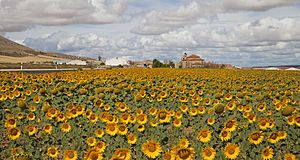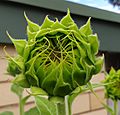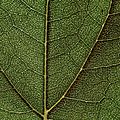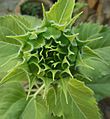Sunflower facts for kids
Quick facts for kids Sunflower |
|
|---|---|
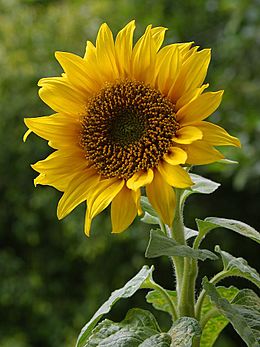 |
|
| Scientific classification | |
| Kingdom: | |
| Division: | |
| Class: | |
| Order: | |
| Family: | |
| Tribe: | |
| Genus: |
Helianthus
|
| Species: |
H. annuus
|
| Binomial name | |
| Helianthus annuus |
|
The sunflower (Helianthus annuus) is a tall, beautiful plant known for its large, bright yellow flower heads. It's an annual plant, which means it grows, flowers, and dies within one year, then new seeds grow for the next year. Sunflowers belong to the Asteraceae family, which also includes daisies and dandelions.
The stem of a sunflower can grow very tall, sometimes reaching up to 3 metres (about 10 feet)! Its flower head can be as wide as 30 cm (about 1 foot). While most people think of yellow sunflowers, some types, like the California Royal Sunflower, can have burgundy (a mix of red and purple) flower heads.
What looks like one big flower head is actually a group of hundreds or even thousands of tiny flowers called florets. The florets in the center look like the middle of a normal flower, and the outer florets look like yellow petals. Together, they form a "false flower" or pseudanthium. This design helps insects and birds see the flower easily, which helps with pollination, and it allows the plant to produce thousands of seeds.
The sunflower is the official state flower of Kansas, which is why Kansas is sometimes called the "Sunflower State." To grow well, sunflowers need lots of sunshine. They grow best in rich, moist, and well-drained soil. Farmers often plant sunflower seeds about 45 cm (1.5 ft) apart and 2.5 cm (1 in) deep.
Contents
What Does a Sunflower Look Like?
The outer parts that look like petals are called sterile florets. They can be yellow, red, orange, or other colors. The tiny flowers inside the circular head are called disc florets. These disc florets are what turn into the seeds we eat!
The way the flower petals and seeds are arranged in a sunflower head is very special. They form a spiral pattern. Each tiny floret is angled slightly from the next, usually by about 137.5 degrees. This creates a beautiful pattern of connecting spirals. If you count the spirals going one way and then the other, you'll often find they are Fibonacci numbers, like 34 and 55, or even 89 and 144 in very large sunflowers.
Sunflowers usually grow between 1.5 and 3.5 m (5–12 ft) tall. The tallest sunflower ever recorded by Guinness World Records was an amazing 9.17 m (about 30 feet) tall in Germany in 2014! Most types of sunflowers we see are varieties of H. annuus, but there are other kinds too. For example, H. tuberosus, also known as the Jerusalem Artichoke, grows edible tubers underground.
How Sunflowers Were Discovered
Sunflowers were first grown by Native Americans in North America a very long time ago. It was once thought they were first grown in the southeastern US about 5,000 years ago. However, new evidence suggests they might have been first grown in Mexico around 2600 BCE. The oldest fully grown sunflower examples in the US were found in Tennessee and date back to about 2300 BCE.
Many indigenous American peoples saw the sunflower as a symbol of their sun gods. This included groups like the Aztecs and Otomi in Mexico, and the Incas in South America. In 1510, Spanish explorers found sunflowers in the Americas and took their seeds back to Europe.
From Europe, sunflowers were introduced to the Russian Empire. There, people started growing them on a large scale to produce oil. This way of growing sunflowers for oil was later brought back to North America in the mid-20th century, starting the commercial sunflower industry there. In the 18th century, sunflower oil became very popular in Russia, especially for members of the Russian Orthodox Church, because it was allowed during Lent when other fats were not.
In the early 1800s, a merchant named Daniil Bokaryov in Russia developed a way to extract sunflower oil on a large scale. This made sunflower oil even more popular. The town where he lived, Alexeyevka, even has a sunflower on its coat of arms! Of the plants first grown in eastern North America that became important crops, the sunflower is now the most important for the economy.
Sunflowers as Food and More
Sunflower seeds are a popular snack. They are often roasted, with or without salt. You can also find sunflower seeds processed into a spread called Sunbutter, which is a good alternative for people with peanut allergies. In Germany, sunflower seeds are mixed with rye flour to make a popular bread called Sonnenblumenkernbrot. Sunflower seeds are also used as bird food and can be added directly to cooking and salads.
Sunflower oil, which is pressed from the seeds, is used for cooking, in margarine, and even to make biodiesel. It's often cheaper than olive oil. Some types of sunflower oil, called 'high oleic' types, have more healthy fats than olive oil.
After the oil is taken from the seeds, the leftover part is called "cake." This cake is used as food for farm animals. Some newer types of sunflowers have heads that droop downwards. While these might not look as pretty in a garden, farmers like them because they help protect the seeds from birds and some plant diseases.
Sunflowers can also produce latex, which is used to make rubber. Scientists are studying them to see if they can be a good source for making rubber that doesn't cause allergies. Traditionally, some Native American groups planted sunflowers on the north side of their gardens. They called them the "fourth sister" to corn, beans, and squash, which are known as the "three sisters" because they grow well together.
Sunflowers are also amazing at cleaning up soil! They can take out harmful things like lead, arsenic, and uranium from the ground. After the Chernobyl disaster, sunflowers were used to remove dangerous radioactive materials like uranium and cesium-137 from the soil. This process is called phytoremediation.
Images for kids
-
A field of sunflowers in North Carolina.
-
Giant sunflower (H. giganteus)
-
Willowleaf sunflower (H. salicifolius)
-
Jerusalem artichoke (H. tuberosus)
See also
 In Spanish: Girasol para niños
In Spanish: Girasol para niños


